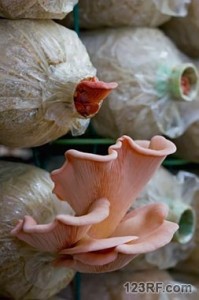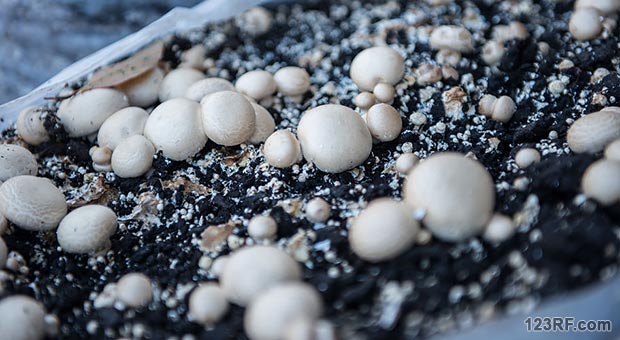In time of need, people will be driven to eat just about anything. While mushrooms are widely accepted as a source of food, trying to consume them from wild sources can be very dangerous.
On the other hand, starting your own mushroom farm now will give you a chance to select safe, nutritious mushrooms for daily use, as well as ones dedicated to medicinal purposes.
Growing Area and Basic Equipment
Most species of mushrooms grow in dark, damp places. While some species prefer temperatures in the low 70‘s, most prefer in the 60‘s. If you do not have a damp, dark cellar with a stable temperature, mushrooms will grow well in damp areas of a forest.
No matter where you decide to grow mushrooms, it is very important to make sure that spores from other mushrooms in the local area do not colonize the growth medium. Aside from taking vital nutrients away from mushrooms of interest, you may wind up growing poisonous mushrooms and not be able to tell the difference.
It is also very important to keep tools as sterile as possible in order to prevent molds, mildew, and other fungi from contaminating the growing area. Most mushroom growers keep a spray bottle with 70% rubbing alcohol on hand as well as sterile gloves.
Even if you are going to spritz the mushrooms or soil with water, you should first wipe down the sprayer nozzle with rubbing alcohol in order to kill off any bacteria or other organisms.
Since you may want to grow several species of mushrooms, it may be best to simply buy pre-designed kits that include the mushroom spores plus all of the necessary tools and trays. If you would prefer not to use a kit, you can set up a growing area using the following tools and supplies:
- Sterilize 20 x 20 trays or poly bags depending on species needs.
- Fill tray or bag with sterile growth medium. See chart for growth mediums for selected mushrooms.
- Make sure growth medium is at a proper temperature to promote growth. A heating pad can be used to raise substrate temperature, or make sure the room stays at the right temperature.
- Viable spores may be collected from fresh mushrooms purchased in the supermarket. Just be sure to select a source that is not contaminated with fungus or spores from poisonous mushroom species (see below for information on how to collect and store mushroom spores.)
- Prepare spores by scraping from spore print paper into sterile, room temperature water in a sterilized flask.
- Mix spore filled liquid with sterile vermiculite
- Use a sterile syringe to cover the growth medium with spores, but do not place soil on top of the spore material.
- Keep compost at approximately 70 degree temperature until white roots (mycellium) appear in the growth mix.
- Once you see evidence of growth, reduce temperature to lower 60‘s and cover box with clear plastic wrap or damp cloth.
- Cover mycellium with 1“ of fine potting soil.
- Compost should be kept moist, but not soaked.
- Some species of mushrooms will be ready to harvest in a matter of days, while others may take months or even years.
Mushroom Growth Habits
 It should be noted that mushrooms grow in flushes. When you inoculate growth medium with spores, they will not all begin developing right away.
It should be noted that mushrooms grow in flushes. When you inoculate growth medium with spores, they will not all begin developing right away.
As the first flush is harvested, you will notice smaller mushrooms beginning to take their place.
Depending on the species, and the amount of growth medium available, you may get several flushes from a single inoculation.
Therefore, when harvesting mushrooms, you should always be careful not to disturb the medium. Carefully cut the stem of the mushroom you want to harvest, and leave the roots in place.
Preserving Spores From Generation to Generation
No matter whether you start off with a mushroom kit or spores from known edible mushrooms, it is very important to learn how to collect and preserve spore prints.
While these steps are not complicated, you must always start off with sterile tools and make sure that the spore collection process remains as controlled as possible. Here are the basic steps:
- Cut stem as close to the cap as possible without shaking or disturbing the cap.
- Place cap on a piece of paper in such a way that gills are sitting on the paper. The paper should be large enough to accommodate the entire mushroom cap.
- Put a few drops of sterile water on top of the cap
- Cover the entire cap with a glass bowl or container.
- Let sit for 24 hours without disturbing.
- After 24 hours, take off the container and lift up the mushroom cap
- You will see the gill pattern left behind on the paper. These are mushroom spores.
- Carefully place the spore bearing papers in a sterilized air and water tight container.
- Store in a cool, dry place until you are ready to use the spores.
If you are particularly interested in crops that grow indoors and require little in the way of light or maintenance, mushrooms will easily meet your needs.
While some mushrooms take longer than others to grow, their medicinal value may make it worth cultivating them. See more about their medical uses in the infographic below and send us your feedback using the comment form:
At the very least, you can start working with easy to grow mushrooms and work your way up to more advanced strains. You will surely take a good advantage of them for survival.
Learn everything you need to know about what vegetables you can grow on Backyard Liberty.






